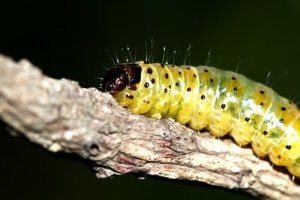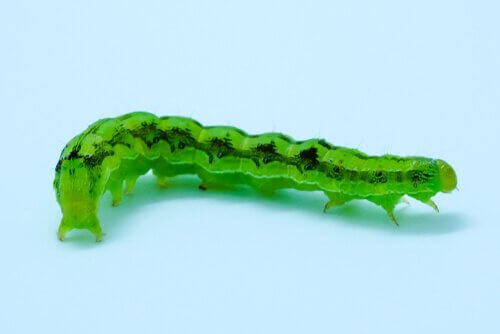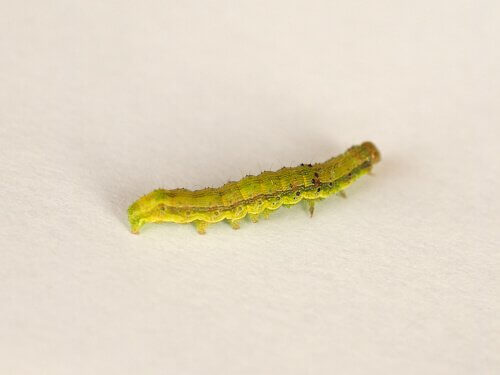The Seven Most Common Caterpillars


Written and verified by the lawyer Francisco María García
Caterpillars are the larvae of the different species of insects that make up the order Lepidoptera. However, the term is also used to designate the larvae of some types of flies and beetles. In today’s article, though, we’ll be looking at seven of the most common caterpillars in the world.
Morphologically, caterpillars are recognized by their cylindrical bodies, and multiple colors and tones. Although the traditional caterpillars are often white or green, there are many with aposematic coloration patterns. These patterns warn possible predators of the caterpillar’s toxicity.
In general, aposematic caterpillars are quite attractive, due to their vivacious and striking colors. Below we’re going to summarize not only the aposematic species, but also the most common types of caterpillars worldwide.
The 7 most common types of caterpillars in the world
1. Machaon caterpillar
This is one of the most common types of caterpillars in plantations, and they give rise to diurnal butterflies. Actually, there are several species included in the large machaon family. They feed mainly on plants such as fennel and rue, from the Apiaceae family.

2. Green donuts
This is another large family of caterpillars, often found on plantations around the world. Despite its name, these caterpillars actually have many different colors, such as yellow, green, and brown.
The most common species of green donut is called Heliothis armigera. In general, they concentrate on the crops of the Solanaceae variety: potatoes, tomatoes, and peppers. However, they also feed on beans and cabbages, and on fruits such as watermelon and melon. They also eat flowers.

3. Worms or gray threads
The types of caterpillars popularly known as threads, or gray worms, belong to the genus Agrotis. These are medium-sized caterpillars, and have a cylindrical body and smooth skin. They may be gray or brown.
Gray threads inhabit soil, and so they usually consume the plant roots and infest them. These caterpillars affect almost every type of crop: lettuce, potatoes, cabbages, peppers, corn, carrots, turnips, fruits, and flowers.

4. Saddleback caterpillar (Acharia stimulea)
Undoubtedly, this is one of the most striking types of caterpillars in nature. However, they’re not as common as the previous ones. This species is native to North America, but it’s also widespread in some South American countries such as Colombia.
In the early stages of development, these caterpillars are completely green and unattractive. But upon reaching the most advanced stages, their body acquires striking aposematic designs in green, brown and white. In addition, they have small spines, or stinging hairs, that play a defensive role by warning off predators.

5. Cabbage worm
These usually morph into two main species of butterflies: Pieris brassicae and Pieris rapae. In general, they inhabit orchards, where they feed mainly on cabbages.
These butterflies are very similar to each other; their predominant color is white with black spots. But, interestingly, the worms have different color patterns. The worms that Pieris brassicae butterflies morph from are black and yellow.
The worms that become Pieris rapae butterflies are completely green, and are easily camouflaged against the cabbage leaves.

6. Green or brown threads
This is a small group of caterpillars with two main species: Spodoptera littoralis and Spodoptera exigua. The popular name refers to their main strategy of defense: these caterpillars twist around when threatened to protect themselves and mislead predators.
Their diet includes almost all types of vegetables. But they prefer melons, watermelons, bananas, peppers, tomatoes, and lettuce.

7. Plusia caterpillar
The plusias, also known as lizards in some parts of the world, are among the most common types of caterpillars in the world. There are numerous species that are very similar to each other. Under this category, the Chrysodeixis chalcites and Autographa gamma stand out.
Chrysodeixis chalcites are large, and of greenish tones mostly. The moths that morph from them are easily recognizable by the crest behind their heads.
They are super predators of crops, orchards, and fields, and they ingest practically everything they have at their disposal. For this reason, farmers consider them very harmful to agriculture.

Caterpillars are the larvae of the different species of insects that make up the order Lepidoptera. However, the term is also used to designate the larvae of some types of flies and beetles. In today’s article, though, we’ll be looking at seven of the most common caterpillars in the world.
Morphologically, caterpillars are recognized by their cylindrical bodies, and multiple colors and tones. Although the traditional caterpillars are often white or green, there are many with aposematic coloration patterns. These patterns warn possible predators of the caterpillar’s toxicity.
In general, aposematic caterpillars are quite attractive, due to their vivacious and striking colors. Below we’re going to summarize not only the aposematic species, but also the most common types of caterpillars worldwide.
The 7 most common types of caterpillars in the world
1. Machaon caterpillar
This is one of the most common types of caterpillars in plantations, and they give rise to diurnal butterflies. Actually, there are several species included in the large machaon family. They feed mainly on plants such as fennel and rue, from the Apiaceae family.

2. Green donuts
This is another large family of caterpillars, often found on plantations around the world. Despite its name, these caterpillars actually have many different colors, such as yellow, green, and brown.
The most common species of green donut is called Heliothis armigera. In general, they concentrate on the crops of the Solanaceae variety: potatoes, tomatoes, and peppers. However, they also feed on beans and cabbages, and on fruits such as watermelon and melon. They also eat flowers.

3. Worms or gray threads
The types of caterpillars popularly known as threads, or gray worms, belong to the genus Agrotis. These are medium-sized caterpillars, and have a cylindrical body and smooth skin. They may be gray or brown.
Gray threads inhabit soil, and so they usually consume the plant roots and infest them. These caterpillars affect almost every type of crop: lettuce, potatoes, cabbages, peppers, corn, carrots, turnips, fruits, and flowers.

4. Saddleback caterpillar (Acharia stimulea)
Undoubtedly, this is one of the most striking types of caterpillars in nature. However, they’re not as common as the previous ones. This species is native to North America, but it’s also widespread in some South American countries such as Colombia.
In the early stages of development, these caterpillars are completely green and unattractive. But upon reaching the most advanced stages, their body acquires striking aposematic designs in green, brown and white. In addition, they have small spines, or stinging hairs, that play a defensive role by warning off predators.

5. Cabbage worm
These usually morph into two main species of butterflies: Pieris brassicae and Pieris rapae. In general, they inhabit orchards, where they feed mainly on cabbages.
These butterflies are very similar to each other; their predominant color is white with black spots. But, interestingly, the worms have different color patterns. The worms that Pieris brassicae butterflies morph from are black and yellow.
The worms that become Pieris rapae butterflies are completely green, and are easily camouflaged against the cabbage leaves.

6. Green or brown threads
This is a small group of caterpillars with two main species: Spodoptera littoralis and Spodoptera exigua. The popular name refers to their main strategy of defense: these caterpillars twist around when threatened to protect themselves and mislead predators.
Their diet includes almost all types of vegetables. But they prefer melons, watermelons, bananas, peppers, tomatoes, and lettuce.

7. Plusia caterpillar
The plusias, also known as lizards in some parts of the world, are among the most common types of caterpillars in the world. There are numerous species that are very similar to each other. Under this category, the Chrysodeixis chalcites and Autographa gamma stand out.
Chrysodeixis chalcites are large, and of greenish tones mostly. The moths that morph from them are easily recognizable by the crest behind their heads.
They are super predators of crops, orchards, and fields, and they ingest practically everything they have at their disposal. For this reason, farmers consider them very harmful to agriculture.

All cited sources were thoroughly reviewed by our team to ensure their quality, reliability, currency, and validity. The bibliography of this article was considered reliable and of academic or scientific accuracy.
- Chrysodeixis chalcites (golden twin-spot moth). (2022). CABI Compendium, CABI Compendium. https://doi.org/10.1079/cabicompendium.13243
- Factsheet – Agrotis species – Cutworms. (s. f.). https://keys.lucidcentral.org/keys/v3/eafrinet/maize_pests/key/maize_pests/Media/Html/Agrotis_species_-_Cutworms.htm
- Firake, D. M. (2022). Pieris brassicae (large cabbage white). CABI Compendium, CABI Compendium. https://doi.org/10.1079/cabicompendium.41157
- Helicoverpa armigera (cotton bollworm). (2022). CABI Compendium, CABI Compendium. https://doi.org/10.1079/cabicompendium.26757
- Macaón. Papilio machaon (Linnaeus, 1758). (s. f.). La Provincia – Diputación de Málaga. https://www.malaga.es/es/laprovincia/naturaleza/lis_cd-9709/macaon-papilio-machaon-linnaeus-1758
- Reserva Natural el Regajal-Mar de Ontígola. (2018). Pappilio machaon. https://www.comunidad.madrid/sites/default/files/doc/medio-ambiente/18-01_mariposa_mes_de_enero.pdf
- Servicio Agronómico. (2014). Noctuidos terrícolas (Gusanos grises). http://www.cooperativaacor.com/extra/descargas/des_12/PUBLICACIONES/Otros-cultivos-I/Patata/2-AP-12.pdf
- Spodoptera littoralis (cotton leafworm). (2022). CABI Compendium, CABI Compendium. https://doi.org/10.1079/cabicompendium.51070
This text is provided for informational purposes only and does not replace consultation with a professional. If in doubt, consult your specialist.








